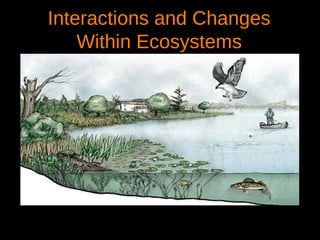Interactions within ecosystems
•Download as PPT, PDF•
8 likes•36,682 views
This document discusses interactions between living things within ecosystems. It describes the five levels of organization within ecosystems from largest to smallest as biome, ecosystem, community, population, and organism. Patterns exist in populations related to living space and time. Population sizes change over time due to factors like predator-prey relationships, birth and death rates, limiting factors, and carrying capacity. Organisms interact through predation, competition, cooperation, and symbiosis. Ecosystems also change over time through ecological succession as one community replaces another.
Report
Share
Report
Share

Recommended
More Related Content
What's hot
What's hot (20)
Viewers also liked
Viewers also liked (6)
Similar to Interactions within ecosystems
Similar to Interactions within ecosystems (20)
More from Brad Kremer
More from Brad Kremer (20)
Recently uploaded
https://app.box.com/s/x7vf0j7xaxl2hlczxm3ny497y4yto33i80 ĐỀ THI THỬ TUYỂN SINH TIẾNG ANH VÀO 10 SỞ GD – ĐT THÀNH PHỐ HỒ CHÍ MINH NĂ...

80 ĐỀ THI THỬ TUYỂN SINH TIẾNG ANH VÀO 10 SỞ GD – ĐT THÀNH PHỐ HỒ CHÍ MINH NĂ...Nguyen Thanh Tu Collection
Recently uploaded (20)
On National Teacher Day, meet the 2024-25 Kenan Fellows

On National Teacher Day, meet the 2024-25 Kenan Fellows
Transparency, Recognition and the role of eSealing - Ildiko Mazar and Koen No...

Transparency, Recognition and the role of eSealing - Ildiko Mazar and Koen No...
Introduction to TechSoup’s Digital Marketing Services and Use Cases

Introduction to TechSoup’s Digital Marketing Services and Use Cases
Play hard learn harder: The Serious Business of Play

Play hard learn harder: The Serious Business of Play
Simple, Complex, and Compound Sentences Exercises.pdf

Simple, Complex, and Compound Sentences Exercises.pdf
80 ĐỀ THI THỬ TUYỂN SINH TIẾNG ANH VÀO 10 SỞ GD – ĐT THÀNH PHỐ HỒ CHÍ MINH NĂ...

80 ĐỀ THI THỬ TUYỂN SINH TIẾNG ANH VÀO 10 SỞ GD – ĐT THÀNH PHỐ HỒ CHÍ MINH NĂ...
NO1 Top Black Magic Specialist In Lahore Black magic In Pakistan Kala Ilam Ex...

NO1 Top Black Magic Specialist In Lahore Black magic In Pakistan Kala Ilam Ex...
Beyond_Borders_Understanding_Anime_and_Manga_Fandom_A_Comprehensive_Audience_...

Beyond_Borders_Understanding_Anime_and_Manga_Fandom_A_Comprehensive_Audience_...
Exploring_the_Narrative_Style_of_Amitav_Ghoshs_Gun_Island.pptx

Exploring_the_Narrative_Style_of_Amitav_Ghoshs_Gun_Island.pptx
HMCS Max Bernays Pre-Deployment Brief (May 2024).pptx

HMCS Max Bernays Pre-Deployment Brief (May 2024).pptx
Interdisciplinary_Insights_Data_Collection_Methods.pptx

Interdisciplinary_Insights_Data_Collection_Methods.pptx
HMCS Vancouver Pre-Deployment Brief - May 2024 (Web Version).pptx

HMCS Vancouver Pre-Deployment Brief - May 2024 (Web Version).pptx
Interactions within ecosystems
- 1. Interactions and Changes Within Ecosystems
- 2. Groups of living things interact within ecosystems The environment can be organized into five levels 1. Biome : region with similar climate, types of plants, and animals 2. Ecosystem: The living and non-living things that interact in one environment. 3. Community: The living organisms of an ecosystem 4. Population: A group of organisms of the same species that live in the same area. 5. Organism: A single living thing, made up of one or many cells, that is capable of growing and reproducing.
- 3. Patterns Exist in Populations Patterns in Living Space Animals in a habitat are located based on food supplies, water, and shelter locations. Some animals live in large groups for safety ( fish and elephants )
- 4. Patterns in Time Population sizes can change with seasons Many organisms migrate to other areas (monarch butterflies and birds)
- 5. Populations Change Over Time Population growth and decline Predator-prey interactions can affect population increase or decrease ( as a wolf population increases the moose population decreases) Birth rate may decline or increase http://www.sciencedaily.com/images/2007/10/071019183055-large.jpg
- 6. Populations Change Over Time Limiting factors: any factor or condition that limits the growth of a population in an ecosystem (food, water, light, large group of predators, small group of prey) http://www.tpwd.state.tx.us/learning/hunter_education/homestudy/wildlife/wildlife/limit.phtml?print=true
- 7. Maintaining a Balance in an Ecosystem Carrying Capacity: the maximum number of individuals that an ecosystem can support. Limiting factors affect the carrying capacity http://www.hunter-ed.com/images/graphics/carrying_capacity_chart.gif
- 8. Interactions among members of a community.
- 9. Organisms Interact in Different Ways Organisms may cooperate, compete, or depend on each other for survival Predator and Prey relationships Predators can affect how the prey populations are distributed (fish in large groups) Prey can affect the location and number in predator populations (birds feeding on insects migrate to the areas where the insects are plentiful)
- 10. Organisms Interact in Different Ways Competition Competition is the struggle between individuals of the same species (intraspecific) or different species populations (interspecific) for a limited resource
- 11. ¡ Intraspecific competition can happen with the same species (plants compete for light, space, and nutrients) ¡ Interspecific competition between different species (hyenas and vultures compete for remains of dead animals)
- 12. Survival of One Species Might Depend on Another Species Symbiosis: two different species who live together in a close relationship Both species benefit >> mutualism One species benefits while the other is not affected >> commensalism One species benefits while the other is harmed >> parasitism
- 13. Types of Symbiosis Mutualism:Two species interacting with each other that benefits both species. (bees and flowers; savanna herbivores and oxpecker birds)
- 14. Types of Symbiosis Commensalism: two species interacting with each other with one species benefiting and the other unaffected. (jellyfish and fish; remora sharks)
- 15. Types of Symbiosis Parasitism: two species interacting while one species benefits and the host species is harmed Examples of human parasites.
- 16. Three Types of Succession
- 17. Ecosystems change over time Ecological Succession: the gradual change in an ecosystem in which one biological community is replaced by another.
- 18. Primary Succession Primary succession: The establishment of a new biological community in an area of bare rocks. (plants moving in after a lava flow or glacier retreats)
- 19. Secondary Succession Secondary Succession: Occurs after a major disturbance happens and the soil still remains. (after a forest fire or agricultural field abandoned)
